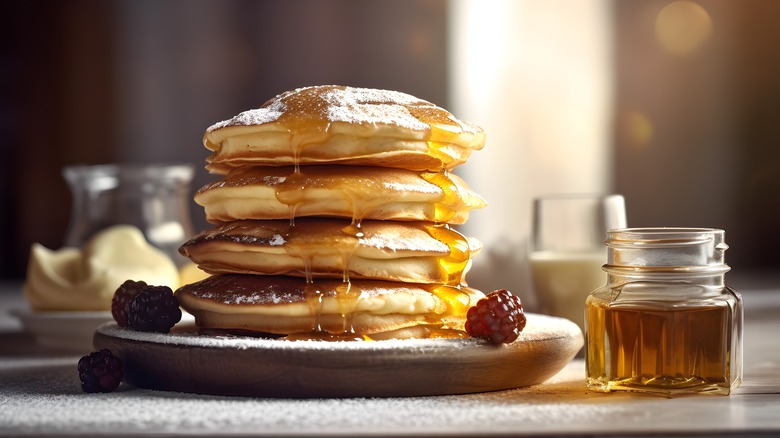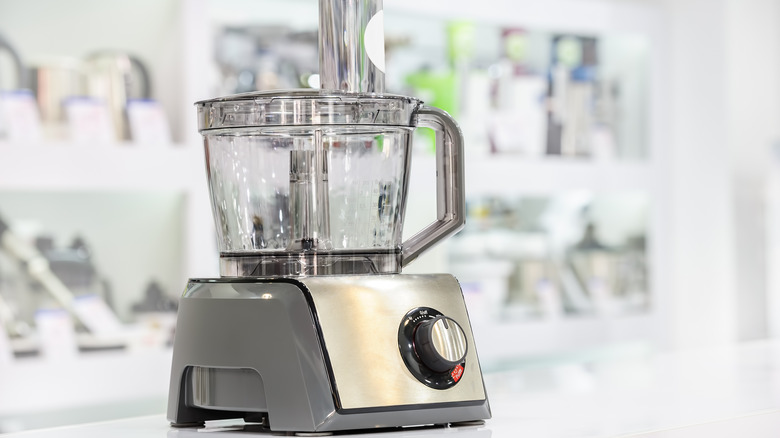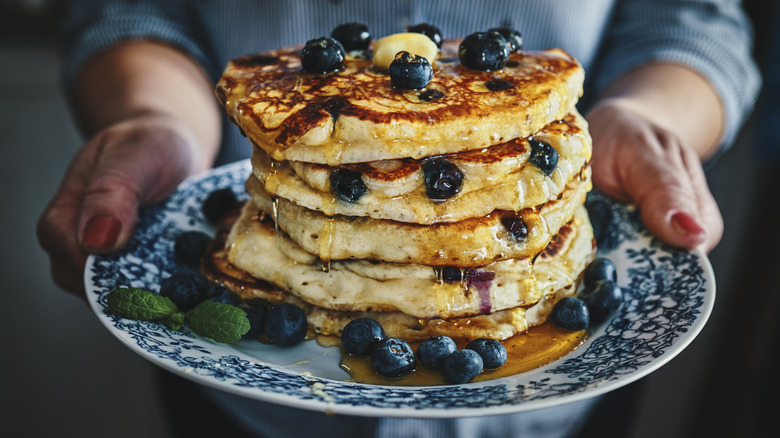Your Food Processor Is A Slept-On Tool For Making Pancake Batter
Breakfast – it's the most important meal of the day! Whether you prefer a savory spread of bacon and eggs or a comforting plate of biscuits and gravy, there's no wrong way to do breakfast. As delicious as a savory morning meal is, a sweet breakfast is an easy way to sneak in some indulgence before you tackle the day. Whether it's a creamy bowl of honey-kissed oatmeal or a blueberry muffin dusted with sugar, there are dozens of dessert-inspired breakfasts to enjoy. But what sweet breakfast is as classic as a stack of pancakes? Fluffy, satiating, and customizable to boot, you can make your pancake prep easier by mixing your batter with a food processor. Because sometimes, elbow grease before noon just isn't the vibe.
Whether you make pancakes from scratch or opt for a boxed mix, using a food processor to combine the ingredients will reduce the work required to achieve a smooth, well-mixed batter. While both blenders and food processors are adept at blending and emulsifying heavy ingredients, using a food processor gives you more agency over the batter's consistency as you can pulse and pause on demand, which prevents overmixed matter. This reduces the likelihood of chewy, dense pancakes due to over-developed gluten. Simply combine your ingredients, pulse the processor, and cook your pancakes.
Tips for making food processor pancake batter
Making pancake batter in a food processor is easy, but with a few tips, your pancake game will go from ordinary to extraordinary. For starters, always use a well-cleaned food processor to ensure that no debris from past recipes gets into your pancakes.
Combine and pulse the dry ingredients before introducing the wet ingredients to evenly distribute the rising agents. This step is critical because it guarantees a uniform texture throughout each pancake. Although it's not entirely necessary, using room-temperature wet ingredients can help achieve that light and fluffy texture of great pancakes. However, bear in mind that dairy and non-dairy milk shouldn't be left out of the refrigerator for more than two hours.
You'll know the batter is at the right consistency when it is thick, not watery, and slightly lumpy. Resting pancake batter will do wonders for your breakfast as the lumps will slowly disappear and you can begin cooking. If your processor doesn't have a pouring spout, use a funnel to transfer the batter into a condiment squeeze bottle or a pourable food storage container. However, you can always ladle the batter from your processor directly into your pan.
Jazzing up your pancake batter
Food processors are the ultimate emulsifier, which means you can seamlessly infuse the batter with additional ingredients to give your pancakes added depth of flavor. Here are some easy ideas for jazzing up your food processor pancake batter.
One easy way to add a flavorful flair to your pancakes is by dotting the batter with maple syrup, honey, agave nectar, or date syrup. A little bit goes a long way, and you don't want to mess with the texture, so add a little, pulse the processor, and double-check that you haven't strayed too far from the consistency you're looking for. Dust the batter with cinnamon, brown sugar, nutmeg, or all three, and process the spice-studded batter to imbue it with a subtle warmth. This adds dimension to the more neutral-tasting ingredients in your batter.
If you like pancakes crafted with berries and fruit but don't like the mouthfeel of squishy, whole fruits, a food processor is your best friend. Mixing fruit into the batter with a food processor breaks it down to a smoother texture, releasing its flavors and juices while giving an organic pop of color. Craving something hearty? You can also process bacon or sausage into the batter to enjoy a batch of savory and sweet pancakes.
Whether you like them classic or creative, next time you're craving pancakes, make your life easier by preparing the batter in a food processor.


